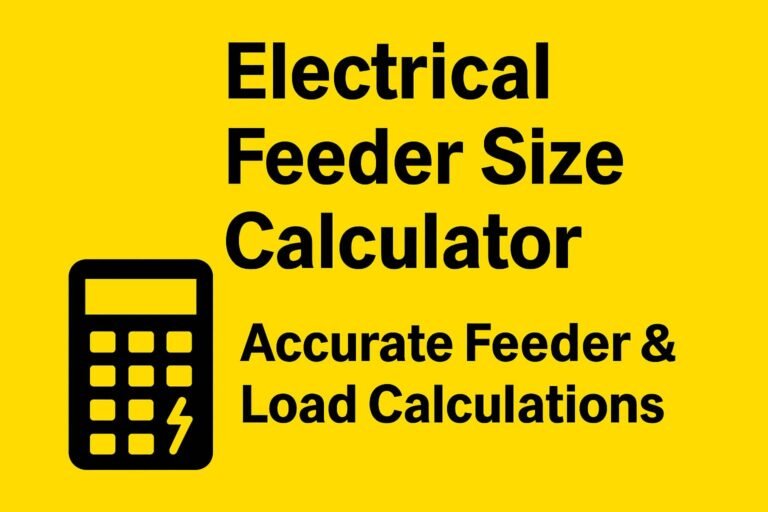Electrical Junction Box Size Calculator – Accurate Sizing for Safe Electrical Installations
Finding the right size for an electrical junction box is one of the most important steps in any wiring installation. Many electrical faults come from crowded boxes, loose connections, or overheating due to lack of space. This is where an electrical junction box size calculator becomes extremely useful. It helps electricians, engineers, and homeowners choose the correct box size based on conductor count, wire gauge, and device volume. This guide explains how sizing works, how to calculate it, and how to use a calculator with accuracy.

Table of Contents
Choosing the wrong size box can lead to violations of wiring standards, unsafe installations, and difficulty during maintenance. A properly sized box ensures enough room for wires, connectors, grounding conductors, and devices such as switches or outlets. The goal is to maintain safety, proper airflow, and ease of access.
Using an electrical junction box size calculator takes the guesswork out of the process. Instead of manually counting conductor volumes and device equivalents, the calculator applies the required rules and gives an instant box size recommendation.
Understanding the Purpose of a Junction Box
A junction box protects wire splices and connections. It provides a covered space for joining circuits safely. It also reduces fire risk, prevents accidental contact with live wires, and supports cable management.
The box must be large enough to allow wires and devices to fit without being compressed. Tight bends or overcrowding can damage insulation. It can also make future repairs more difficult. Use our online tool 3 phase cable size calculator
Sizing a junction box is based on volume, not just dimensions. The total wire volume must not exceed the internal box volume. An electrical junction box size calculator helps ensure this requirement is met.
Electrical Junction Box Size Calculator
Electrical Junction Box Size Calculator
Accurate box-fill sizing using conductor counts, device yokes, internal clamps, grounds, and fittings. Interactive live preview with NEC-style volume allowances and suggested standard box sizes.
| Box type | Nominal size | Volume (in³) | Volume (cm³) |
|---|
– Enter counts of insulated conductors per AWG that enter the box (include spliced and pass-through conductors; exclude pigtails originating inside if permitted by your code).
– Add the number of device yokes (switch/receptacle yokes), internal cable clamps, support fittings, and whether equipment grounding conductors are present.
– Set the largest conductor size present; device yokes, grounds, clamps, and fittings use this size’s volume allowance.
– Click “Calculate” to see required box volume and PASS/FAIL against common standard box sizes. Select a box with volume ≥ required. Always confirm against manufacturer datasheets and local code.
Double-checked rules: Required box volume = Σ(volume per conductor size × conductor count) + (grounds? 1 × largest-volume : 0) + (internal clamps × largest-volume) + (support fittings × largest-volume) + (device yokes × 2 × largest-volume). Typical NEC volume per conductor: 18AWG=1.5 in³, 16AWG=1.75 in³, 14AWG=2.0 in³, 12AWG=2.25 in³, 10AWG=2.50 in³, 8AWG=3.00 in³.
What Determines Junction Box Size
Box sizing depends on several factors. Each one contributes to the total volume needed.
Number of Conductors
Every wire inside the box has a space value. The calculator adds these based on gauge. Try our free online tool today ev charger cable size calculator
Wire Gauge
Different gauges require different volume allowances. Thicker wires need more space.
Devices Inside the Box
Switches, outlets, or similar devices count as extra volume.
Internal Cable Clamps
If the box has built-in clamps, they also count toward the calculation.
Ground Wires
Ground conductors all together count as one conductor.
Pigtails
Pigtail wires count in specific situations based on their function.
These factors are part of the National Electrical Code volume calculations, and a calculator helps apply them correctly. Access our powerful online calculator now star delta motor cable size calculator
Wire Volume Requirements Based on Gauge
The table below shows the volume needed per conductor based on wire size. This is necessary for understanding how an electrical junction box size calculator works.
| Wire Gauge (AWG) | Minimum Volume Allowance per Conductor (cu. in) |
|---|---|
| 18 AWG | 1.5 |
| 16 AWG | 1.75 |
| 14 AWG | 2.0 |
| 12 AWG | 2.25 |
| 10 AWG | 2.5 |
| 8 AWG | 3.0 |
| 6 AWG | 5.0 |
The calculator uses these values to compute the required total volume of the box. Get instant results with our online tool earth cable size calculator
How to Use an Electrical Junction Box Size Calculator
Using a calculator is simple. You enter the number of conductors, the wire gauge, and any devices inside. The calculator then gives the minimum box volume needed.
Here is a step-by-step outline of how the process works.
Step 1: Count All Conductors
Count the hot, neutral, and traveler wires entering or leaving the box.
Step 2: Count Ground Wires
All grounding wires together count as one conductor.
Step 3: Count Devices
Each switch or receptacle counts as two conductors. A calculator adds this value automatically.
Step 4: Include Internal Clamps
If clamps are molded into the box, they count as one conductor.
Step 5: Select the Wire Gauge
The calculator uses gauge to determine the volume required per wire.
Step 6: Get the Total Volume
The calculator multiplies the number of conductor equivalents by the volume per conductor to determine the minimum box size.
This saves time and prevents errors, especially when multiple wires and devices are involved. Start using our easy-to-use online tool earthing cable size calculator
Manual Calculation Example
Let’s understand this with a simple example. Imagine you have a box with the following:
- 4 insulated conductors (hot and neutral wires)
- 1 switch
- 1 equipment ground bundle
- 12 AWG wires
Here is the breakdown:
| Item | Conductor Count |
|---|---|
| Insulated wires | 4 |
| Ground wires | 1 |
| Switch device | 2 |
| Total conductor equivalents | 7 |
Volume needed:
7 conductors × 2.25 cu. in (for 12 AWG) = 15.75 cu. in
So, the minimum box size required is a box with a volume of at least 16 cu. in.
An electrical junction box size calculator performs all this instantly. Calculate instantly with our smart online tool cable size calculator australia
Common Box Sizes and Their Volumes
The table below lists common box types and their internal volumes. This is useful when selecting the correct enclosure.
| Box Type | Dimensions (inches) | Volume (cu. in) |
|---|---|---|
| 1-Gang Plastic | 3 x 2 x 3 | 14 |
| 1-Gang Metal | 2 x 3 x 2.5 | 12.5 |
| 2-Gang Plastic | 3 x 4 x 3 | 30 |
| 2-Gang Metal | 4 x 4 x 1.5 | 21 |
| 4″ Square Metal | 4 x 4 x 1.25 | 18 |
| 4″ Square Metal | 4 x 4 x 2.125 | 30 |
| Round Ceiling Box | 4 x 1.5 | 15 |
Comparing your required volume with these standard sizes helps select the right one.
Why Using a Junction Box Calculator Is Better Than Guessing
Many installations fail because the installer assumed a box “looked big enough.” Wire count and device volume often exceed expectations. A calculator applies a consistent method every time. Experience fast and accurate results using our online tool cable size calculator uk
Some benefits include:
- Better compliance with electrical standards
- Fewer installation errors
- Faster project planning
- Accurate sizing for complex wiring
- Increased safety
When working with multiple circuits, travelers, dimmers, or smart switches, calculations become more complicated. The calculator simplifies these tasks.
Typical Scenarios Where You Need a Calculator
There are many real-world situations where using an electrical junction box size calculator is essential.
Adding New Outlets
When extending a circuit, new conductors increase box fill volume.
Smart Switch Installations
Smart devices often need additional wires like neutrals, making the box more crowded.
Ceiling Fan or Light Fixture Connections
Fan-rated boxes need larger volume due to heavier wiring. Explore our professional online tool for quick calculations kw to cable size calculator
Remodeling or Upgrading Old Wiring
Older boxes may not meet today’s volume requirements.
Running Multiple Circuits in One Box
More circuits mean more wires, so the box must be sized correctly.
A calculator helps avoid guesswork and ensures each scenario is handled correctly.
Tips for Choosing the Right Junction Box
Here are simple tips that help complement the calculator results:
- Choose a box with extra space for easier future changes
- Use deeper boxes where possible
- Keep conductor splices short to reduce clutter
- Avoid mixing too many wire gauges in one box
- Use external clamps instead of internal ones to save volume
- Always allow extra space for pigtails
Picking a box with a slightly higher volume than the minimum required is always a good practice. Make your task simple with our online tool electrical cable size calculator
Conclusion
An electrical junction box size calculator is a valuable tool for anyone working with electrical wiring. It ensures accuracy, safety, and compliance with box fill standards. Instead of relying on estimates, the calculator applies the proper rules for wire count, gauge, devices, and clamps to determine the right box size.
Correct box sizing prevents overheating, wire damage, and electrical hazards. It also makes maintenance easier and keeps your installation neat and safe. With the help of this calculator and the guidelines provided above, you can choose the right junction box confidently for any wiring project. Access our powerful online calculator now Electrical Diversity Calculator for accurate Load Estimation and efficient electrical Design.
Follow Us on Social:
Subscribe our Newsletter on Electrical Insights for latest updates from Electrical Engineering Hub
#ElectricalJunctionBox, #JunctionBoxSizeCalculator, #ElectricalSafety, #HomeWiring, #ElectricalInstallations, #DIYElectrical, #ConduitSizing, #ElectricalPlanning, #ElectricalTools, #WiringAccessories






